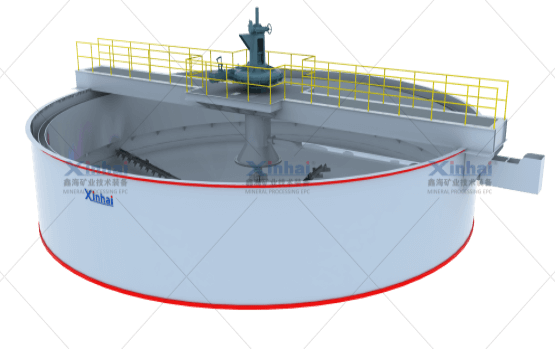Thickeners play an extremely important role in the production of the mineral processing industry. On the one hand, thickeners can increase the solid content of the slurry and reduce the area of the tailings pond. On the other hand, they also have a positive impact on the recycling of water resources and water conservation. Since thickeners are so important, you should consider many aspects when purchasing them and choose the right equipment to get higher profits.
Before purchasing a thickener, we must first clarify the needs of the company, which mainly includes the processing capacity of the required thickener, the solid content and characteristics of the slurry.
(1) Processing capacity of the required thickener
Make sure that the processing capacity of the thickener can meet your needs to avoid equipment that is too large or too small, resulting in resource waste or production bottlenecks.
Processing capacity evaluation method: Calculate the required processing capacity based on your production scale and process flow. For example, if your mineral processing plant needs to process 1,000 cubic meters of slurry per hour, choosing a thickener with a processing capacity of 1,200 cubic meters per hour can ensure smooth production while leaving a certain margin.
(2) Solid content of slurry
Determine the required solid content based on your process requirements. For example, if your process requires the solid content of the tailings to reach 50%, it is crucial to choose a thickener that can meet this requirement.
(3) Characteristics of the slurry
The characteristics of the slurry directly affect the selection and operation of the thickener. Therefore, before purchasing a thickener, the characteristics of the slurry should be understood through laboratory analysis and field testing. For example, particle size analysis, density testing, and viscosity measurement should be performed to provide a scientific basis for selection.

There are many types of thickeners, and each type is divided into different sizes. Therefore, when purchasing a thickener, it is necessary to ensure that the selection is reasonable, and then ensure the concentration efficiency and obtain the expected product.
(1) Thickener type
The types of thickeners can be roughly divided into four types: ordinary thickeners, high-efficiency thickeners, deep cone thickeners and inclined plate thickeners.
a. Ordinary thickeners
Ordinary thickeners have a simple structure and low cost. They are suitable for processing slurries with medium solid content and are widely used in small-scale concentrators.
b. High-efficiency thickeners
High-efficiency thickeners use high-efficiency flocculants and optimized sedimentation area design, with fast sedimentation speed and high processing capacity. They are widely used in large-scale concentrators and can significantly improve the solid content and water resource recovery rate.
c. Deep cone thickeners
Deep cone thickeners have a compact structure, small footprint, fast sedimentation speed, and are suitable for processing slurries with high solid content. They are also widely used in large-scale concentrators.
d. Inclined plate thickener
The inclined plate thickener has a small footprint, large processing capacity, high efficiency, convenient operation and maintenance management, high underflow concentration and low overflow turbidity. It is suitable for tailings treatment and concentrate concentration in medium-sized concentrators.
(2) Thickener size
The equipment size directly affects the processing capacity and sedimentation effect. Larger thickeners usually have higher processing capacity and better sedimentation effect, but the cost is also higher.
Evaluation method: Select the appropriate equipment size based on the processing capacity and solid content requirements. For example, a high-efficiency thickener with a processing capacity of 1,200 cubic meters per hour usually has a diameter of about 20 meters.
(3) Flocculant system
An efficient flocculant system can significantly increase the sedimentation rate and solid content, reduce the amount of flocculant used, and reduce operating costs.
Evaluation method: Select a flocculant system with automatic dosing function and precise control to ensure uniform addition of flocculants and better effects.